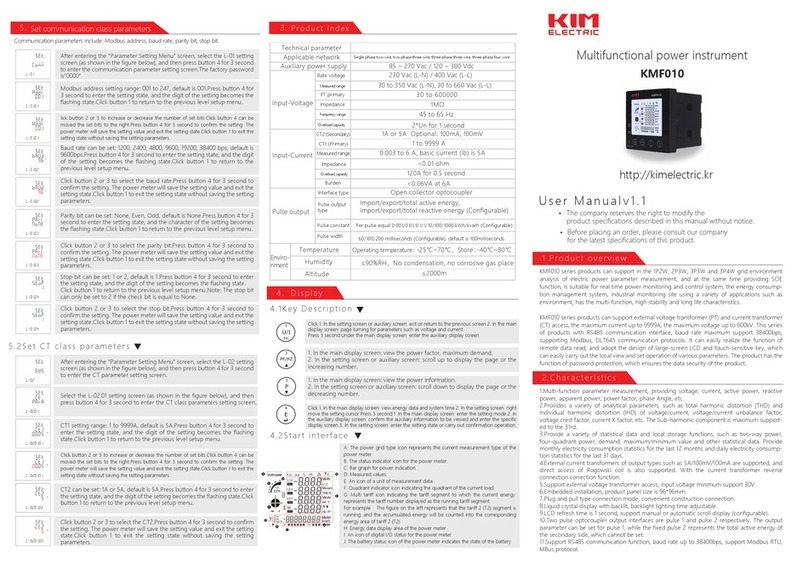
KMF000 series
Chapter 1 Overview
1.1. Introduction
PAC5000 series products are the multi-function power analysis instrument for collection and
analysis of electric parameters, used not only in the electricity transmission and power distribution
system, but also in the power consumption measurement and analysis in high voltage intelligent
power grid. This series of products that can support a variety of electric parameter measurement
analysis, such as voltage, current, the four quadrant power parameters, power factor, total
harmonic distortion, individual harmonic distortion, unbalance factor, crest factor, etc. This series
of products also provide a variety of electrical energy parameters measurement, such as two-way
active energy, reactive energy, four-quadrant energy, monthly and daily energy consumption
statistics.
PAC5000 series products can support in the 1P2W, 2P3W, 3P3W and 3P4W grid environment
analysis of electric power parameter measurement, and at the same time providing multi-channel
digital input/output interface, and SOE function, is suitable for real time power monitoring and
control system, the energy consumption management system, industrial monitoring site using a
variety of applications such as environment, has the multi-function, high stability and long life
characteristics.
PAC5000 series products can support external voltage transformer (PT) and current transformer
(CT) access, the maximum current up to 9999A, the maximum voltage up to 600kV. This series of
products with RS485 communication interface, baud rate maximum support 38400bps, supporting
Modbus, DLT645 communication protocols. It can easily realize the function of remote data read,
and adopt the design of large-screen LCD and touch-sensitive key, which can easily carry out the
local view and set operation of various parameters. The product has the function of password
protection, which ensures the data security of the product.
1.2. Characteristics
Multi-function parameter measurement, providing voltage, current, active power, reactive
power, apparent power, power factor, phase Angle, etc.
Provides a variety of analytical parameters, such as total harmonic distortion (THD) and
Individual harmonic distortion (IHD) of voltage/current, voltage/current unbalance factor,
voltage crest factor, current K factor, etc. The Sub-harmonic component is maximum
supported to the 63rd.
Provide a variety of statistical data and local storage functions, such as two-way power,
four-quadrant power, demand, maximum/minimum value and other statistical data. Provide
monthly electricity consumption statistics for the last 12 months and daily electricity
consumption statistics for the last 31 days.
External current transformers of output types such as 5A/100mV/100mA are supported, and
direct access of Rogowski coil is also supported. With the current transformer reverse
connection correction function.
Support external voltage transformer access, input voltage minimum support 30V.
Embedded installation, product panel size is 96*96mm.
Plug and pull type connection mode, convenient construction connection.





























